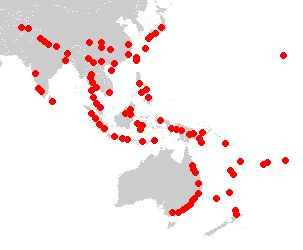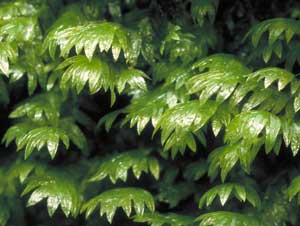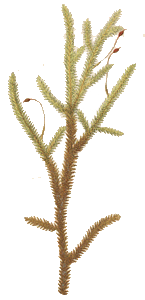
Bryogeography
Australia and elsewhere
The relationships between Australian bryophytes and those of the rest of the world are quite varied. There are endemic, cosmopolitan and Gondwanan species to give just some examples. Australia's long isolation from the rest of the world has led to the evolution of numerous animals and plants that are unique to this continent, so it should be no surprise to learn that millions of years of isolation have seen the evolution of many endemic bryophytes. Before that isolation Australia was part of the super-continent of Gondwana. The major products of the break-up of Gondwana are Australasia, Antarctica, South America, Africa and India. Current bryophytes that evolved from Gondwanan ancestors could therefore show a variety of distributions, depending on the ancestral distribution in Gondwana. For example, if an ancestor were widely distributed in Gondwana, the current descendants might be found in all of the areas listed above. A much more restricted ancestral distribution would imply a more restricted distribution of today's descendants. Finally, the break-up of Gondwana was not a single event, with some areas breaking off millions of years before others. Therefore areas that separated more recently are likely to have far more species in common than areas that separated long ago![]() .
.
This page will be devoted to species that are found overseas as well as in Australia. Look at the ENDEMIC AUSTRALIAN BRYOPHYTES page for information about endemic species.
The aim of this page is to illustrate various distribution patterns with a few examples, rather than an exhaustive list, of each. The examples will mostly be at the species level, with only a few comments about the higher classification categories of genus and family. This page will be largely descriptive, rather than full of theories as to how the distributions of the various species arose. For many species more detective work will be needed before it's possible to propose some well-supported hypotheses as to the reasons behind their current distributions. In some cases all the species in a genus have the same distribution pattern and those cases will be noted here. However there are far more genera in which all the species do not show the same distribution. There are many PROBLEMS AND PUZZLES in Australian bryogeography and by following that link you can find out more. That also gives more context to the information on this page and is essential reading for a proper understanding of the issues of Australian bryogeography.
Finally, you should remember that no bryogeographical account is ever complete. A species listed as endemic to Australia today may be discovered overseas next week. In addition, many areas in Australia have been poorly explored from a bryological perspective and each year sees additional species recorded for Australia. Some are totally new species, not yet known from anywhere else in the world. Others are newly found in Australia, but already known outside Australia. There are many examples of species that many expect will be found in Australia. For example, there are numerous bryophytes, not yet recorded from Australia, but with a distribution from Indonesia, the island of New Guinea and through to the islands of the South Pacific. Given such a wide distribution and the closeness of Australia to the island of New Guinea, it be very surprising if some such species did not occur in northern Australia.
Australia , Asia and the Pacific
Once the tectonic plate carrying Australia had collided with the Asian plate, it became possible for bryophytes to move between Australia and Asia.
The paper given in the following reference button surveys the mosses of the Wet Tropics region of northern Queensland. The area studied extends from Townsville to Cooktown and from the coast inland to the peaks of the Great Dividing Range, the highest reaching 1600 metres. The authors stated that about 45% of the moss species had affinities with south-east Asia, particularly with Malesia. For many of those species the Queensland Wet Tropics area represents the south-east extremity of their distributions![]() .
.
There are many bryophytes with a distribution that extends from Asia to Australia and possibly on to the islands of the South Pacific. For many such species the Asian distribution is confined to Malesia while for some the distribution extends to Asian areas more distant from Australia. This section will give some examples of bryophytes with a distribution extending to the more distant Asian areas. The next section will deal with species confined to the Australasian "neighbourhood".
|
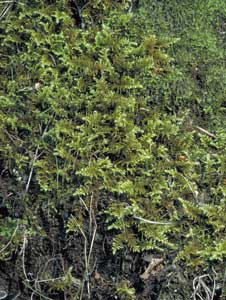 |
The red dots on the accompanying map show the distribution of the moss Thuidium cymbifolium. It is a good example of a species with a distribution that extends from Australia well into Asia (as well as to various Pacific islands, including Hawai'i). Pyrrhobryum bifarium and Rhizogonium distichum, two other mosses, are found in Tasmania, parts of south-east mainland Australia as well as New Zealand and South-East Asia. Pyrrhobryum latifolium is found in eastern Queensland, roughly between Maryborough and Cooktown, throughout Malesia and also in Japan. Pogonatum neesii is found on the eastern Australian mainland, from western Victoria to north Queensland, the western Pacific, Japan, Taiwan through much of Malesia and South-east Asia to the northwest extremity of Yunnan Province in China![]() .
.
Metzgeria lindbergii is a thallose liverwort known from Australasia, east Asia and parts of the Pacific (including Tahiti and Hawai'i). The leafy liverworts Mastigolejeunea indica, Plagiochila obtusa and Plagiochila teysmanii are found from northern Australia to South-east Asia, with the first of the three found as far north-west as Yunnan Province in China. Caudalejeunea cristiloba, another leafy liverwort, is known from Queensland, the Solomon Islands, parts of Malesia, Thailand, Myanmar, the Andaman Islands and Sri Lanka.
The Australian neighbourhood
The word "neighbourhood" is a good choice for the heading of this section because the word has a usefully imprecise meaning in everyday speech. Some people will interpret neighbourhood more widely than others. In this section we'll look at some bryophytes that are found in Australasia and surrounding areas that are not too far away. That sort of definition allows for a variety of distribution patterns.
Erpodium hodgkinsoniae ![]() is found along much of the east coast of Queensland and slightly across the border into north-east New South Wales. Outside Australia this moss has been found only on Norfolk Island. Trichostomum eckelianum (or Tortella cirrhata, the older name you will still see in many references)
is found along much of the east coast of Queensland and slightly across the border into north-east New South Wales. Outside Australia this moss has been found only on Norfolk Island. Trichostomum eckelianum (or Tortella cirrhata, the older name you will still see in many references) ![]() is another moss and is widespread in southern Australia from east to west and is also known from Lord Howe Island and Norfolk Island. The leafy liverwort Chiloscyphus fisisstipus
is another moss and is widespread in southern Australia from east to west and is also known from Lord Howe Island and Norfolk Island. The leafy liverwort Chiloscyphus fisisstipus ![]() is known from eastern Australia (Tasmania to Queensland) and from Norfolk Island and Porella crawfordii, another leafy liverwort, is known from parts of New South Wales and Queensland, in mainland Australia, as well as Lord Howe Island and possibly Norfolk Island. The thallose liverwort Metzgeria hebridensis is known from Queensland, New Caledonia, Vanuatu and the island of New Guinea.
is known from eastern Australia (Tasmania to Queensland) and from Norfolk Island and Porella crawfordii, another leafy liverwort, is known from parts of New South Wales and Queensland, in mainland Australia, as well as Lord Howe Island and possibly Norfolk Island. The thallose liverwort Metzgeria hebridensis is known from Queensland, New Caledonia, Vanuatu and the island of New Guinea.
Various bryophytes are confined to Australia and New Zealand (and sometimes one or more of the nearby tropical to sub-Antarctic islands). Examples of these are:
mosses:
Breutelia elongata , Fissidens leptocladus (right), Hymenodon pilifer, Leptostomum inclinans, Ptychomnion aciculare, Pyrrhobrym paramattense
, Ulota laticillata
thallose liverworts:
Asterella tenera , Hymenophyton flabellatum
, Riccardia eriocaula, Metzgeria rigida, Metzgeria submarginata
leafy liverworts:
Chaetophyllopsis whiteleggei
, Clasmatocolea strongylophylla, Lepidolaena reticulata, Lethocolea pansa
, Plagiochila intertexta, Schistochila balfouriana
, Telaranea patentissima, Trichocolea mollissima
hornwort:
Megaceros denticulatus
For a sizeable number of the bryophytes which are essentially Australian and New Zealand in distribution, south-east Australia is the only area where you will find them in Australia. The area referred to is composed of Tasmania, Victoria, the Australian Capital Territory and south-east New South Wales. Amongst those species there are many that, in Australia, are confined to just Victoria and Tasmania or even just Tasmania. The species underlined in the above list are those which, in Australia, are found only in Tasmania.
The moss Macromitrium involutifolium subspecies ptychomitrioides ![]() occurs in eastern mainland Australia, Norfolk Island, New Caledonia and the Tubai Islands in French Polynesia. Leptostomum macrocarpon
occurs in eastern mainland Australia, Norfolk Island, New Caledonia and the Tubai Islands in French Polynesia. Leptostomum macrocarpon ![]() is another tropical to sub-tropical moss with a similar range to the east of Australia. In Australia it is found from south-eastern Queensland to the Fitzroy Falls in New South Wales. Outside those states it occurs on Lord Howe and Norfolk Islands, in New Zealand and on various Polynesian Islands.
is another tropical to sub-tropical moss with a similar range to the east of Australia. In Australia it is found from south-eastern Queensland to the Fitzroy Falls in New South Wales. Outside those states it occurs on Lord Howe and Norfolk Islands, in New Zealand and on various Polynesian Islands.
The moss Powellia integra is known from the Cairns area in Queensland and, outside Australia, it grows in Fiji and through Malesia. Pyrrhobryum latifolium, another moss, is known from eastern Queensland and throughout Malesia. In 2006 the leafy liverwort Siphonolejeunea schiffneri was reported from the Kirrima Range in northern Queensland. Before then it had been recorded only from Java and Papua New Guinea. The leafy liverwort Herbertus longifissus is known from eastern Queensland and otherwise from Indonesia to Tahiti while the leafy liverwort Mastigolejeunea undulata is found in northern Australia, the island of New Guinea, the Moluccas and the Philippines.
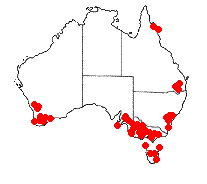 |
The accompanying map shows the Australian distribution of the moss Sematophyllum homomallum. It is far more common in the temperate south of the country. It shows a disjunct distribution in the south and the map gives the impression that the Nullarbor Plain is too inhospitable for it. That is certainly possible. On the other hand the species is reasonably dry tolerant and seemingly fairly tolerant of salt spray as well. It is found in tree trunks or exposed rocks in sclerophyll forests and coastal or inland heathy scrubs, rarely in swampy areas. Outside Australia the species is known from New Zealand, eastern Malesia and parts of Oceania![]() .
.
The thallose liverwort Riccardia wattsiana ![]() is widespread in Australia and is also found on Norfolk Island and the island of New Guinea. The moss Pogonatum tubulosum is another species that is found on the island of New Guinea but, in Australia, is known only from north-east Queensland. The moss Mittenia plumula is the only species in the genus Mittenia. It is found in eastern Australia from Tasmania to Queensland and is also known from the south-west of Western Australia. Outside Australia it is known from New Zealand and from just a few sites on the island of New Guinea. This suggests that this species is essentially an Australian- New Zealand one but is in the early stages of a spread north into the island of New Guinea.
is widespread in Australia and is also found on Norfolk Island and the island of New Guinea. The moss Pogonatum tubulosum is another species that is found on the island of New Guinea but, in Australia, is known only from north-east Queensland. The moss Mittenia plumula is the only species in the genus Mittenia. It is found in eastern Australia from Tasmania to Queensland and is also known from the south-west of Western Australia. Outside Australia it is known from New Zealand and from just a few sites on the island of New Guinea. This suggests that this species is essentially an Australian- New Zealand one but is in the early stages of a spread north into the island of New Guinea.
The moss Tayloria octoblepharum ![]() is found in the south-west of Western Australia, Tasmania and in eastern mainland Australia from near Adelaide in South Australia through to south-east Queensland in a broad band that follows the coast but extends to include the Great Dividing Range. Outside Australia the species is found in New Zealand, Papua New Guinea and the sub-Antarctic islands south of Tasmania and New Zealand.
is found in the south-west of Western Australia, Tasmania and in eastern mainland Australia from near Adelaide in South Australia through to south-east Queensland in a broad band that follows the coast but extends to include the Great Dividing Range. Outside Australia the species is found in New Zealand, Papua New Guinea and the sub-Antarctic islands south of Tasmania and New Zealand.
NEXT – Australia and far away
![An Australian Government Initiative [logo]](/images/austgovt_brown_90px.gif)


